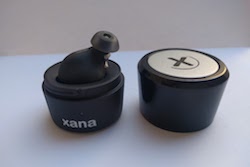World’s first non-invasive vagus nerve stimulation stress reducer
According to EU-OSHA (European Agency for Safety and Health at Work) about 50 % of European workers consider stress common to their workplace and it contributes to around 50 % of all lost working days. Current treatment options for stress are limited in their efficacy. They can lead to further psychophysiological complications, are time consuming and are frequently expensive. Looking for a non-invasive, fast-acting and effective treatment, the EU-funded XANA project developed a wearable device which stimulates the vagus nerve to relieve stress. The mobile solution also comes with a range of integrated functions such as performance feedback and monitoring, as well as access to professional counselling. The emergent field of bioelectric medicine There is currently no specific pharmaceutical treatment for stress. Benzodiacepines, (minor tranquilizers), are most commonly prescribed but are actually designed more for anxiety disorders. Furthermore, anxiolytics (such as Benzodiacepines) can have severe side effects such as cognitive impairment, or occasionally aggression, especially after prolonged use. On the other hand, safe alternatives that rely on psychological techniques such as mindfulness or psychotherapy, require long-term commitment to regular practice, relying on the willpower of users and skill of the therapists. Introducing the XANA project, coordinator Dr. Miguel Lopez, says, “The starting point for the project is the understanding that regardless of external triggers, what brings on the experience of stress is a personal response to those triggers, and this can be modulated. The XANA solution reduces stress in a safer and more immediate way, compared to the main therapeutic alternatives.” The non-invasive bioelectronic XANA system takes advantage of the vagus nerve, the longest nerve in the autonomic nervous system. This nerve is a key part of the parasympathetic ‘rest and digest’ nervous system, passing electrical signals between the brain, heart, lungs and digestive tract and so has a significant impact on mental health. XANA, through its ear-embedded Heart Rate Monitor, is able to calculate HRV (heart rate variability), an index of the vagal tone which can be checked on the accompanying smartphone app. In this way the system can monitor stress levels for each individual, as well as the impact of the neuro-stimulation during vagus nerve stimulation (nVNS) treatment. The era of mobile healthcare Within the EU, stress is the second most common reason for work sick leave resulting in a very high cost to the economies of each Member State, collectively estimated to be more than EUR 300 billion per year. Exposure to stress for short periods, has been associated with a range of illnesses and disorders, including: mood changes, fatigue, headaches, sleep disturbance, and digestive irritability. Longer exposure has been shown to be associated with a wide range of mental and physical health problems, including: anxiety, depression, suicide attempts, sleep problems, back pain, chronic fatigue, digestive problems, autoimmune disease, poor immune function, cardiovascular disease, high blood pressure and peptic ulcers. Summarising the likely impact of XANA, Dr. Lopez says, “Undoubtedly, it will be a unique and powerful preventive tool that will improve quality of life for many Europeans. This mobile-health approach will also reduce the burden on healthcare systems by offering real-time treatment options, with remote medical monitoring and/or counselling as appropriate.” Currently the team are running two clinical studies to evaluate the safety and efficacy of the XANA device, with the aim of obtaining the CE mark of quality assurance.
Keywords
XANA, stress, relaxation, harmony, non-invasive, vagus nerve stimulation, psychophysiological, bioelectric medicine, neurotransmitters, healthcare, therapeutic



